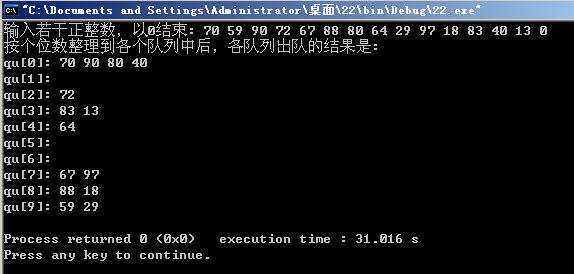数据结构第七周项目4--队列数组
2017-12-14 10:25
246 查看
/*
*Copyright(c)2017,烟台大学计算机与控制工程学院
*All rights reserved.
*作 者:刘浩
*版 本 号:v1.0
问题描述:创建10个队列,分别编号为0-9(处理为队列数组,编号即下标)。
输入若干个正整数,以数字0作为结束。
设输入的值为x,其个位数字的大小为i,则将x插入到编号为i的队列中。
最后输出所有的非空队列。
要求将队列处理成链式队列,使用链式队列算法库中定义的数据类型及算法,
程序中只包括一个函数(main函数),入队和出队等操作直接在main函数中调用即可。
*/
头文件.h:
[cpp] view
plain copy
#ifndef LIQUEUE_H_INCLUDED
#define LIQUEUE_H_INCLUDED
typedef int ElemType;
typedef struct qnode
{
ElemType data;
struct qnode *next;
} QNode; //链队数据结点类型定义
typedef struct
{
QNode *front;
QNode *rear;
} LiQueue; //链队类型定义
void InitQueue(LiQueue *&q); //初始化链队
void DestroyQueue(LiQueue *&q); //销毁链队
bool QueueEmpty(LiQueue *q); //判断链队是否为空
int QueueLength(LiQueue *q); //返回队列中数据元素个数
void enQueue(LiQueue *&q,ElemType e); //入队
bool deQueue(LiQueue *&q,ElemType &e); //出队
#endif // LIQUEUE_H_INCLUDED
源文件.cpp:
[cpp] view
plain copy
#include <stdio.h>
#include <malloc.h>
#include "liqueue.h"
void InitQueue(LiQueue *&q) //初始化链队
{
q=(LiQueue *)malloc(sizeof(LiQueue));
q->front=q->rear=NULL;
}
void DestroyQueue(LiQueue *&q) //销毁链队
{
QNode *p=q->front,*r; //p指向队头数据节点
if (p!=NULL) //释放数据节点占用空间
{
r=p->next;
while (r!=NULL)
{
free(p);
p=r;
r=p->next;
}
}
free(p);
free(q); //释放链队节点占用空间
}
bool QueueEmpty(LiQueue *q) //判断链队是否为空
{
return(q->rear==NULL);
}
int QueueLength(LiQueue *q) //返回队列中数据元素个数
{
int n=0;
QNode *p=q->front;
while (p!=NULL)
{
n++;
p=p->next;
}
return(n);
}
void enQueue(LiQueue *&q,ElemType e) //入队
{
QNode *p;
p=(QNode *)malloc(sizeof(QNode));
p->data=e;
p->next=NULL;
if (q->rear==NULL) //若链队为空,则新节点是队首节点又是队尾节点
q->front=q->rear=p;
else
{
q->rear->next=p; //将*p节点链到队尾,并将rear指向它
q->rear=p;
}
}
bool deQueue(LiQueue *&q,ElemType &e) //出队
{
QNode *t;
if (q->rear==NULL) //队列为空
return false;
t=q->front; //t指向第一个数据节点
if (q->front==q->rear) //队列中只有一个节点时
q->front=q->rear=NULL;
else //队列中有多个节点时
q->front=q->front->next;
e=t->data;
free(t);
return true;
}
main函数:
[cpp] view
plain copy
#include <stdio.h>
#include <malloc.h>
#include "liqueue.h"
#define N 10
int main()
{
int i, a;
LiQueue *qu
; //定义队列指针数组
for (i=0; i<N; i++)
InitQueue(qu[i]); //初始化队列
//为队列中加入值
printf("输入若干正整数,以0结束: ");
scanf("%d", &a);
while(a)
{
enQueue(qu[a%10], a);
scanf("%d", &a);
}
//输出各个队列
printf("按个位数整理到各个队列中后,各队列出队的结果是: \n");
for (i=0; i<N; i++)
{
printf("qu[%d]: ", i);
while(!QueueEmpty(qu[i]))
{
deQueue(qu[i], a);
printf("%d ", a);
}
printf("\n");
}
//销毁各个队列
for (i=0; i<N; i++)
DestroyQueue(qu[i]);
return 0;
}
运行结果:

*Copyright(c)2017,烟台大学计算机与控制工程学院
*All rights reserved.
*作 者:刘浩
*版 本 号:v1.0
问题描述:创建10个队列,分别编号为0-9(处理为队列数组,编号即下标)。
输入若干个正整数,以数字0作为结束。
设输入的值为x,其个位数字的大小为i,则将x插入到编号为i的队列中。
最后输出所有的非空队列。
要求将队列处理成链式队列,使用链式队列算法库中定义的数据类型及算法,
程序中只包括一个函数(main函数),入队和出队等操作直接在main函数中调用即可。
*/
头文件.h:
[cpp] view
plain copy
#ifndef LIQUEUE_H_INCLUDED
#define LIQUEUE_H_INCLUDED
typedef int ElemType;
typedef struct qnode
{
ElemType data;
struct qnode *next;
} QNode; //链队数据结点类型定义
typedef struct
{
QNode *front;
QNode *rear;
} LiQueue; //链队类型定义
void InitQueue(LiQueue *&q); //初始化链队
void DestroyQueue(LiQueue *&q); //销毁链队
bool QueueEmpty(LiQueue *q); //判断链队是否为空
int QueueLength(LiQueue *q); //返回队列中数据元素个数
void enQueue(LiQueue *&q,ElemType e); //入队
bool deQueue(LiQueue *&q,ElemType &e); //出队
#endif // LIQUEUE_H_INCLUDED
源文件.cpp:
[cpp] view
plain copy
#include <stdio.h>
#include <malloc.h>
#include "liqueue.h"
void InitQueue(LiQueue *&q) //初始化链队
{
q=(LiQueue *)malloc(sizeof(LiQueue));
q->front=q->rear=NULL;
}
void DestroyQueue(LiQueue *&q) //销毁链队
{
QNode *p=q->front,*r; //p指向队头数据节点
if (p!=NULL) //释放数据节点占用空间
{
r=p->next;
while (r!=NULL)
{
free(p);
p=r;
r=p->next;
}
}
free(p);
free(q); //释放链队节点占用空间
}
bool QueueEmpty(LiQueue *q) //判断链队是否为空
{
return(q->rear==NULL);
}
int QueueLength(LiQueue *q) //返回队列中数据元素个数
{
int n=0;
QNode *p=q->front;
while (p!=NULL)
{
n++;
p=p->next;
}
return(n);
}
void enQueue(LiQueue *&q,ElemType e) //入队
{
QNode *p;
p=(QNode *)malloc(sizeof(QNode));
p->data=e;
p->next=NULL;
if (q->rear==NULL) //若链队为空,则新节点是队首节点又是队尾节点
q->front=q->rear=p;
else
{
q->rear->next=p; //将*p节点链到队尾,并将rear指向它
q->rear=p;
}
}
bool deQueue(LiQueue *&q,ElemType &e) //出队
{
QNode *t;
if (q->rear==NULL) //队列为空
return false;
t=q->front; //t指向第一个数据节点
if (q->front==q->rear) //队列中只有一个节点时
q->front=q->rear=NULL;
else //队列中有多个节点时
q->front=q->front->next;
e=t->data;
free(t);
return true;
}
main函数:
[cpp] view
plain copy
#include <stdio.h>
#include <malloc.h>
#include "liqueue.h"
#define N 10
int main()
{
int i, a;
LiQueue *qu
; //定义队列指针数组
for (i=0; i<N; i++)
InitQueue(qu[i]); //初始化队列
//为队列中加入值
printf("输入若干正整数,以0结束: ");
scanf("%d", &a);
while(a)
{
enQueue(qu[a%10], a);
scanf("%d", &a);
}
//输出各个队列
printf("按个位数整理到各个队列中后,各队列出队的结果是: \n");
for (i=0; i<N; i++)
{
printf("qu[%d]: ", i);
while(!QueueEmpty(qu[i]))
{
deQueue(qu[i], a);
printf("%d ", a);
}
printf("\n");
}
//销毁各个队列
for (i=0; i<N; i++)
DestroyQueue(qu[i]);
return 0;
}
运行结果:

相关文章推荐
- 第七周 数据结构实践项目——队列 【项目4 - 队列数组】
- 数据结构第七周项目-队列数组
- 数据结构第七周项目4--队列数组
- 第七周项目四C/C++数据结构实践——队列数组
- 第七周项目4-队列数组
- 第七周项目4-队列数组
- 第七周 项目4 队列数组
- 第七周项目4-队列数组
- 第七周项目4队列数组
- 第七周项目4--队列数组
- 第七周 项目四 队列数组
- 第七周 项目 4 - 队列数组
- 第七周项目4—队列数组
- 第七周项目四__队列数组
- 第七周项目4-队列数组
- 第七周——项目4—“队列数组”
- 第七周项目4——队列数组
- 数据结构 第七周项目三 负数把正数赶出队列
- 第七周项目4——队列数组
- 第七周 项目四 队列数组
